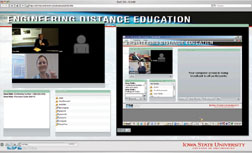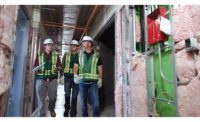Construction engineering students at Iowa State University, Ames, are getting a close-up look at distant project sites, and an enriched learning experience, through two-way portable jobsite video technology now being tested there.
| + click to enlarge |
 Students in Iowa were linked to jobsite 225 miles away in Kansas City.
|
The approach by the university’s Dept. of Civil, Construction and Environmental Engineering combines hand-held video cameras, laptops with video capability, wireless jobsite links and the Internet to allow students to view live streaming video from jobsites and interact with site personnel in real time. Use of off-the-shelf web-conferencing software also allows display of project documents alongside the live video feed. The result: a live jobsite walk-around from the comfort of the classroom. “It makes a big difference when you actually see what’s going on at the site,” says Cory McDermott, a construction engineering graduate student.
The department’s Distance Learning project is the brainchild of Edward J. Jaselskis, department professor and group leader. “We’re usually limited to visiting projects in and around Ames and Des Moines,” he says. “This approach allows students greater exposure to a variety of projects.” He is now talking with peers at American University in Cairo, Egypt, about sharing webcasts.
“The beauty of using a web-conferencing platform is that anyone with a computer and Internet connection can join the online class session,” says Jaselskis. “In addition to live video from the jobsite, you can display drawings and run computer applications like schedules or project-management software to present to the live virtual classroom.” Live webcasts also are captured and archived for later viewing as video clips.
The jobsite hookup was launched last October when Jaselskis teamed with Eric Floyd, an assistant vice president at JE Dunn Construction Group, Kansas City, to test the technology at Dunn’s 205,000-sq-ft headquarters building under construction about 225 miles away. The first live session occurred earlier this year. A WiFi hub that JE Dunn installed provides jobsite connectivity. It allows the video signal to be sent wirelessly to a router on site, typically in the jobsite trailer, and then to the Internet. Presenters walk the site, answering students’ questions as they go. Audio is provided by a cell phone call from the jobsite to a classroom speakerphone.
|
"Anyone with a computer and Internet connection can join the online class session." —EDWARD JASELSKIS, PROFESSOR, IOWA STATE U.
|
Paul Jewell, distance learning program coordinator, compiled the portable video technology. The key jobsite components are a laptop with built-in video camera for headshots of the speakers and a hand-held video camera connected to the laptop for longer distance shots, he says. The mobile system at the jobsite costs about $3,000. Web-conferencing software is an additional cost, about $1,000 or less for an unlimited annual user license. The technology is off the shelf but requires a fair amount of implementation time and experience to refine the transmission, Jewell says.
The biggest challenge is determining whether jobsite Internet connectivity will transmit video signals, Jewell says. Even with JE Dunn’s WiFi hub, live video requires considerable bandwidth. Video transmissions are sometimes spotty. Jewell and Jaselskis are now experimenting with wireless laptop cards that boost bandwidth but are more expensive.
Iowa State officials and other construction educators say they do not know of other schools using similar technology. The university is moving to fine-tune the technology and link with other construction jobsites. This fall, it will again use the video link at the JE Dunn site and may do likewise on future Kansas City-based Black & Veatch projects.



Post a comment to this article
Report Abusive Comment